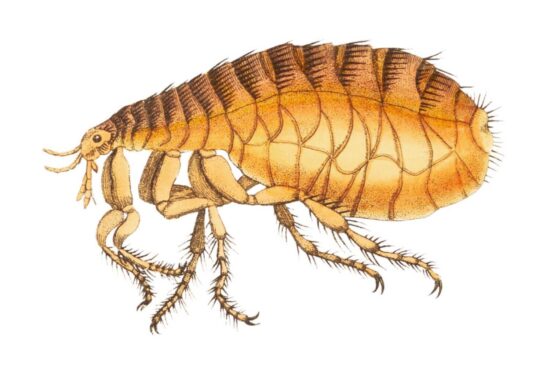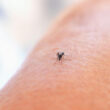Fleas are some of the most annoying pests you’ll ever deal with. These tiny, jumping bugs can make both you and your pets absolutely miserable. If you’ve noticed your dog or cat scratching more than usual, or if you’re getting mysterious itchy bites around your ankles, you probably have a flea problem.
Here’s the thing about fleas: they multiply fast. Really fast. A single female flea can lay up to 50 eggs every single day. That means in just a few weeks, a small flea problem can turn into a nightmare. The good news? You can get rid of them completely if you know how to get rid of fleas properly and stick with it.
Getting rid of fleas isn’t a one-day job. It usually takes several weeks to completely eliminate them because you’re not just fighting the adult fleas you can see. You’re also dealing with eggs, larvae, and pupae hiding all over your house. But don’t worry! This guide will walk you through exactly how to get rid of fleas effectively, step by step.
1. Take Care of Your Pets First
This is hands down the most important step. If you have pets, they’re probably where the fleas are living and breeding. Until you treat your furry friends, everything else you do will only provide temporary relief.
Call your vet right away. Don’t try to handle this with random products from the pet store. Modern flea treatments from veterinarians are incredibly effective. They can kill fleas within 6 to 24 hours of contact, and they keep working for weeks.
Your vet might recommend:
- Topical treatments that you apply to your pet’s back
- Oral medications that work from the inside out
- Flea collars that provide long-term protection
Here’s something really important: if you have multiple pets, you need to treat ALL of them at the same time. Even if you only see fleas on one pet, the others probably have them too. All cats and dogs in the house need to be flea treated or the problem won’t be fixed.
Skip the flea shampoos. Those drugstore flea shampoos might seem like a good idea, but they only kill the adult fleas that are on your pet right now. Once you rinse the shampoo off, it stops working. You need something that keeps killing fleas for weeks.
Comb your pets regularly. Get a fine-tooth flea comb and check your pet’s fur, especially around the neck and tail where fleas like to hang out. Keep a cup of hot soapy water nearby. When you catch fleas in the comb, dip it in the water to drown them. This also helps you monitor whether your treatment is working.
Keep treating your pets year-round. Once you get rid of the current infestation, don’t stop the flea prevention. The best way to avoid future household infestations is to maintain pets on a preventive treatment regimen. It’s much easier to prevent fleas than to get rid of them.
2. Vacuum Every Single Day
Vacuuming every day to remove eggs, larvae and adults is the best method for initial control of a flea infestation, according to the EPA. This isn’t just helpful – it’s absolutely essential.
Why vacuuming works so well: The warmth and vibration from your vacuum actually tricks flea pupae into hatching. When they come out as adults, they immediately jump toward the vibration (thinking it’s an animal), and you suck them right up. Even better, any fleas that survive the trip into your vacuum will jump onto your treated pets later and die.
What to vacuum:
- All carpeted areas, especially where your pets sleep and play
- Upholstered furniture and cushions
- Cracks and crevices along baseboards
- Area rugs and mats
- Pet bedding areas
- Under furniture where pets like to hide
Do this every day for at least 10 days straight. Yes, it’s a lot of work, but it makes a huge difference. Pay particular attention to areas where pets sleep.
Empty your vacuum immediately. As soon as you’re done vacuuming, take that bag or canister straight to your outside trash. Don’t let it sit in your house. Some fleas might still be alive in there, and you don’t want them getting back out.
Pro tip: If you have a bagless vacuum, you can sprinkle some diatomaceous earth or baking soda in the canister before you start. This will help kill any fleas that get sucked up.
3. Hit Them with Heat Treatment
Heat is one of fleas’ biggest enemies. High temperatures kill fleas at every stage of their life cycle, from eggs to adults. You can use heat in two main ways: steam cleaning and hot water washing.
Steam clean everything you can. Steam clean carpets: the hot steam and soap can kill fleas in all stages of the life cycle. Focus on:
- All carpeted areas
- Upholstered furniture
- Mattresses where pets sleep
- Curtains and drapes
- Any fabric that can’t be washed
The combination of hot steam and soap is deadly to fleas. Make sure you get into all the crevices and corners where fleas might be hiding.
Wash everything in hot water. Wash all pet bedding and family bedding on which pets lie in hot, soapy water every two to three weeks. Use the hottest water setting that’s safe for the fabric (ideally 140°F or higher).
What to wash:
- All pet bedding and blankets
- Your own bedding if pets sleep on your bed
- Curtains and washable rugs
- Pet toys and clothing
- Removable furniture covers
- Any fabric your pets come into contact with
Dry everything on high heat too. The hot air in your dryer will kill any fleas or eggs that survived the washing machine.
Replace heavily infested items. If an infestation is severe, discard old pet bedding and replace it with fresh, clean material. Sometimes it’s easier and more effective to just start fresh.
4. Try Natural Dehydrating Treatments
If you prefer natural methods or want to avoid chemicals, there are several safe options that work by drying out fleas and their eggs. These methods are particularly good for families with small children or pets with sensitive skin.
Diatomaceous Earth (Food-Grade Only)
- Kills fleas, ants, roaches, and more
- Includes powder duster for easy, targeted application
- Works indoors and outdoors, long-lasting when dry
- 100% pure, food-grade, safe around pets and kids
Diatomaceous earth, or DE, is made from tiny fossilized organisms. Diatomaceous earth (DE) kills fleas by cutting through their exoskeleton with sharp edges and dehydrating them by absorbing oils and fats.
Here’s how to use it:
- Buy only food-grade DE (never use pool-grade)
- Sprinkle a thin layer on carpets and upholstery
- Work it into the fibers with a brush or broom
- Leave it for 1 to 3 days
- Vacuum everything up thoroughly
Important safety notes: Avoid breathing in the dust as it can dry out and irritate the airways of humans and pets. Wear a mask and keep pets out of treated areas until you vacuum it up. Also, DE only works when it’s completely dry, so don’t use it in humid areas.
Salt Treatment
Regular table salt works similarly to DE by dehydrating fleas. Grind your salt into a fine powder (a coffee grinder works great), then sprinkle it on carpeted areas. Let it sit for 12 to 48 hours, then vacuum it up. Sprinkling salt where fleas are active will also dehydrate the eggs and insects.
Baking Soda Method
Baking soda kills fleas by dehydrating them. Sprinkle baking soda on your carpets and furniture, then scrub it deep into the fibers with a stiff brush. Leave it for several hours or overnight, then vacuum thoroughly.
What to expect: These natural methods mainly kill adult fleas and eggs. They won’t eliminate pupae (the cocoon stage), so you’ll need to repeat the treatment several times as new fleas hatch. Understanding how to get rid of fleas naturally takes patience, but these methods are safe and effective when used consistently.
5. Set Up Flea Traps for Monitoring
Flea traps won’t solve your flea problem by themselves, but they’re incredibly useful for figuring out where fleas are most active and whether your treatments are working. Flea traps utilizing a light and a glue board can be useful in capturing adult fleas and monitoring the status of treatment.
No products found.
The Dish Soap Trap
This is the simplest and most popular DIY flea trap:
- Fill a shallow bowl with warm water
- Add a tablespoon of liquid dish soap and mix it in
- Place a desk lamp directly over the bowl
- Turn off all other lights in the room
- Leave it overnight
Fleas are attracted to the warmth and light. When they jump toward the lamp, they land in the soapy water and can’t get out. The soap breaks the surface tension, so they sink and drown.
Safety first: Keep kids and pets away from this setup. Water and electricity don’t mix, so make sure the lamp is stable and the cord is safely positioned.
Where to place traps: Set up traps in different rooms each night to figure out where your flea problem is worst. Focus on areas where your pets spend time, like near their beds or favorite lounging spots.
Corn Syrup Alternative
Mix equal parts corn syrup and water, bring it to a boil, then let it cool completely. Pour it into a shallow dish and set up the same way as the soap trap. Fleas will stick to the syrup when they jump toward the light.
Commercial traps: One of the most effective flea traps on the market uses an alternating on-off (green) light to simulate the shadow of a passing animal. These can be worth buying if you want something more sophisticated.
6. Use Essential Oil Repellents Carefully
Essential oils can help repel fleas, but they’re more of a prevention tool than a cure. If you want to try them, you need to be very careful, especially if you have cats.
Safe oils for dogs: When properly diluted, these oils may help repel fleas:
- Lemon eucalyptus
- Cedarwood
- Citronella
- Lavender
- Neem oil
How to use them: Always dilute essential oils in a carrier like witch hazel or coconut oil. Never apply undiluted oils directly to pets or furniture. Mix a few drops into a spray bottle with water and test it on a small area first.
Warning about cats: Cats, in particular, are acutely sensitive due to their inability to metabolize certain compounds found in many essential oils. Many oils that are safe for dogs can be toxic to cats. Always check with your vet before using any essential oils around cats.
Other natural repellents:
- Cedar chips in pet areas and around your yard
- Sachets filled with dried lavender, lemon peel, and cedar chips
- Fresh lemon juice mixed with water as a spray
Set realistic expectations: Essential oils work better as repellents than killers. They might help keep new fleas away, but they won’t eliminate an existing infestation. Think of them as part of your prevention strategy, not your main treatment.
7. Don’t Forget About Your Yard
Your outdoor areas can be a major source of fleas, especially if you have pets that spend time outside. Wildlife like raccoons, opossums, and stray cats can drop flea eggs in your yard, creating an ongoing problem.
Beneficial Nematodes: Nature’s Flea Killers
Beneficial nematodes are microscopic beneficial predatory worms that hunt down and kill pest insects but pose no threat to people, pets or plants. The specific types that kill fleas are called Steinernema feltiae and Steinernema carpocapsae.
Here’s what makes them so effective: Steinernema carpocapsae begin killing fleas within 48 hours and will remain in the soil as long as six weeks after the fleas have been eradicated.
How to apply nematodes:
- Buy them from a garden center or online
- Mix with water according to package directions
- Apply with a hose-end sprayer or watering can
- Focus on shaded areas where fleas like to hang out
- Water the area thoroughly before and after application
- Apply when soil temperature is at least 55°F
Where to focus: Fleas won’t be found in areas of full sun, so shady spots and areas where pets hang out are hot spots. Treat under porches, around pet houses, beneath trees, and anywhere your pets like to rest outside.
Yard Maintenance
Keep your lawn and landscaping flea-unfriendly:
- Mow your grass regularly (fleas hate short grass)
- Remove leaf litter and organic debris where larvae develop
- Trim bushes and shrubs to increase sunlight
- Seal up areas where wild animals might nest
- Keep your yard clear of clutter where fleas can hide
Timing matters: Diatomaceous earth needs dry conditions to work. The best time to use it is during a windless, dry day, when you don’t expect rain in the next 24 to 48 hours. The same goes for nematodes – don’t apply them if rain is expected soon after.
8. Consider Professional Help
Sometimes DIY methods aren’t enough, especially for severe infestations or large properties. If you’re wondering how to get rid of fleas when home remedies fail, professional pest control services have access to more powerful treatments and know exactly where to look for hidden flea populations.
Professional Spray Treatments
Professional treatments generally result in an immediate reduction in the number of adult fleas in the home. These treatments use two main types of ingredients:
- Adulticides that kill adult fleas on contact
- Insect Growth Regulators (IGRs) that prevent eggs and larvae from developing into adults
Professional sprays like FRONTLINE HOMEGARD can be applied to carpets, upholstery, and hard-to-reach areas under furniture. The active ingredients have two long-acting components to help control fleas and break the reproductive life cycle.
What to expect: It is common to see more fleas within seven to fourteen days following the treatment. These fleas were in a pre-adult or “pupal” stage of development at the time of the initial treatment. Don’t panic if this happens – it’s actually a sign that the treatment is working.
Full Professional Service
When you hire a pest control company, here’s what they typically do:
- Thorough inspection to find all flea hotspots
- Customized treatment plan based on your specific situation
- Professional-grade equipment for more effective application
- Heat treatments that raise your home’s temperature to kill all life stages
- Follow-up visits to ensure complete elimination
Pest controllers use a strategic approach to eliminate fleas. First, they assess the infestation and treat affected areas with insecticides that target adult fleas and insect growth regulators (IGRs) to stop eggs from hatching.
Cost considerations: Professional flea treatment typically costs between $200 and $600 for most homes, depending on the size of your house and severity of the infestation. While it’s more expensive upfront, it can save you time and frustration if DIY methods aren’t working.
When to call the pros:
- You’ve been fighting fleas for 6-8 weeks with no success
- You have a large property that’s hard to treat yourself
- Family members are having allergic reactions to flea bites
- You have multiple pets and the infestation keeps coming back
- You need professional advice on how to get rid of fleas permanently
9. Plan for Long Term Success
Getting rid of fleas isn’t just about killing the ones you have now. You also need to prevent new infestations and make sure you completely eliminate severe problems.
Prevention is Key
The best way to avoid future household infestations is to maintain pets on a preventive treatment regimen. Here’s your prevention game plan:
- Keep pets on year-round flea prevention even after the infestation is gone
- Vacuum regularly (at least twice a week in pet areas)
- Wash pet bedding weekly in hot water
- Groom pets regularly with a flea comb to catch problems early
- Maintain your yard by mowing and removing debris
- Limit contact with stray animals and wildlife
Managing Severe Infestations
Some flea problems are particularly stubborn and require extra patience and persistence. This can take three months or sometimes longer, depending on the heat and humidity, and the amount of CO2 and vibrations from us and our pets.
What to expect with severe infestations:
- Treatment takes 4+ weeks minimum to see complete results
- Problems may seem worse before they get better as pupae hatch into adults
- Multiple treatment methods work better than relying on just one approach
- Repeat treatments every 3-4 weeks for several months to catch all generations
Combining multiple methods: The most effective approach uses pet treatment plus home treatment plus yard treatment all at the same time. You’re essentially attacking the fleas from every angle so they have nowhere to hide or reproduce.
Track your progress: Keep notes about where you’re seeing fleas and how many you’re catching in traps. This helps you figure out which treatments are working and which areas need more attention.
Don’t give up: It’s also important to know that an infestation can seem to get worse before it gets better. That’s because the flea life stages already in the home are developing and hatching out. Stick with your treatment plan even if you see more fleas at first.
Extreme cases: For really severe infestations, professional heat fumigation or gas fumigation might be necessary. These treatments kill fleas at all life stages throughout your entire home, but they’re expensive and require you to leave your house for several days.



